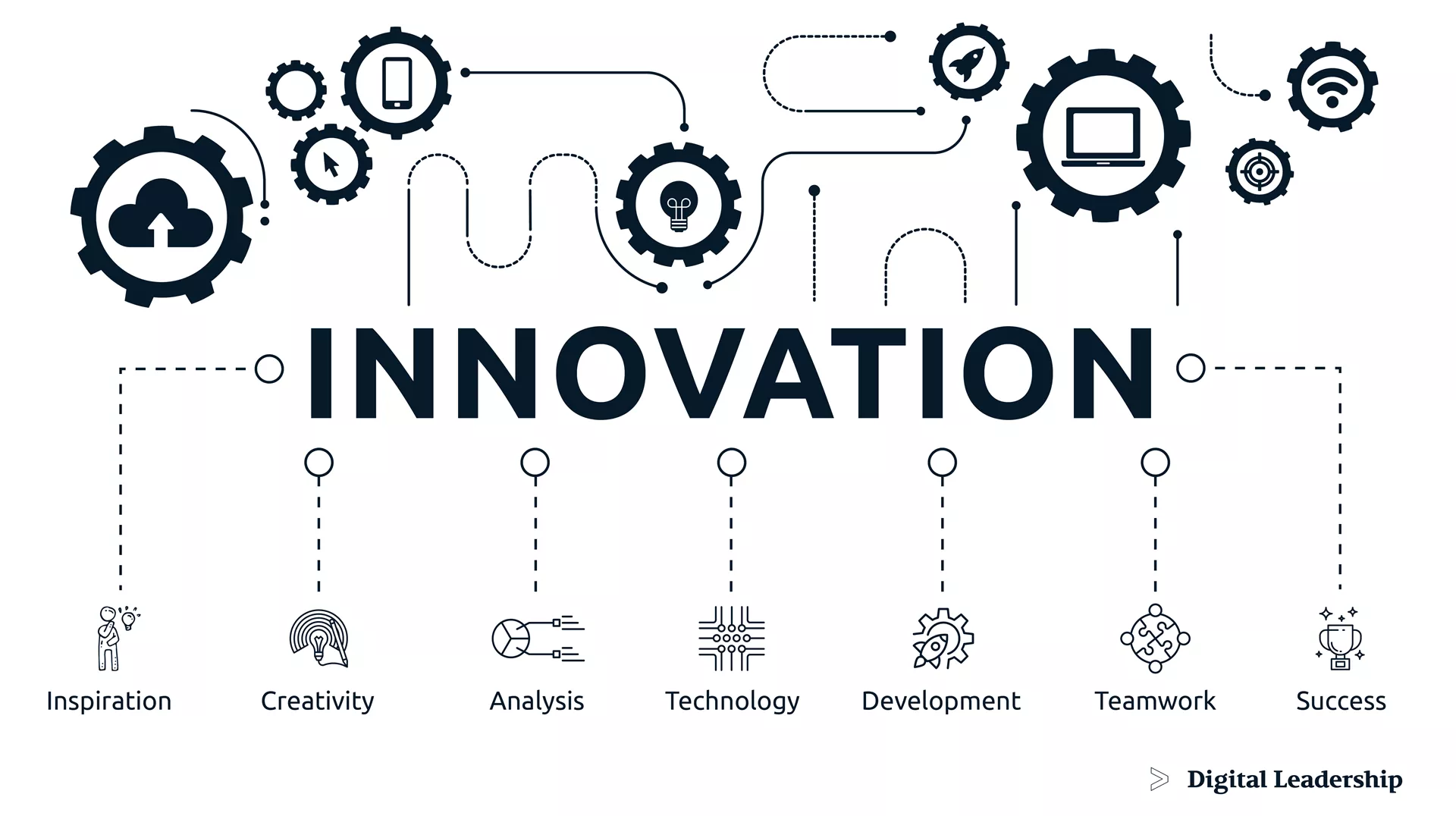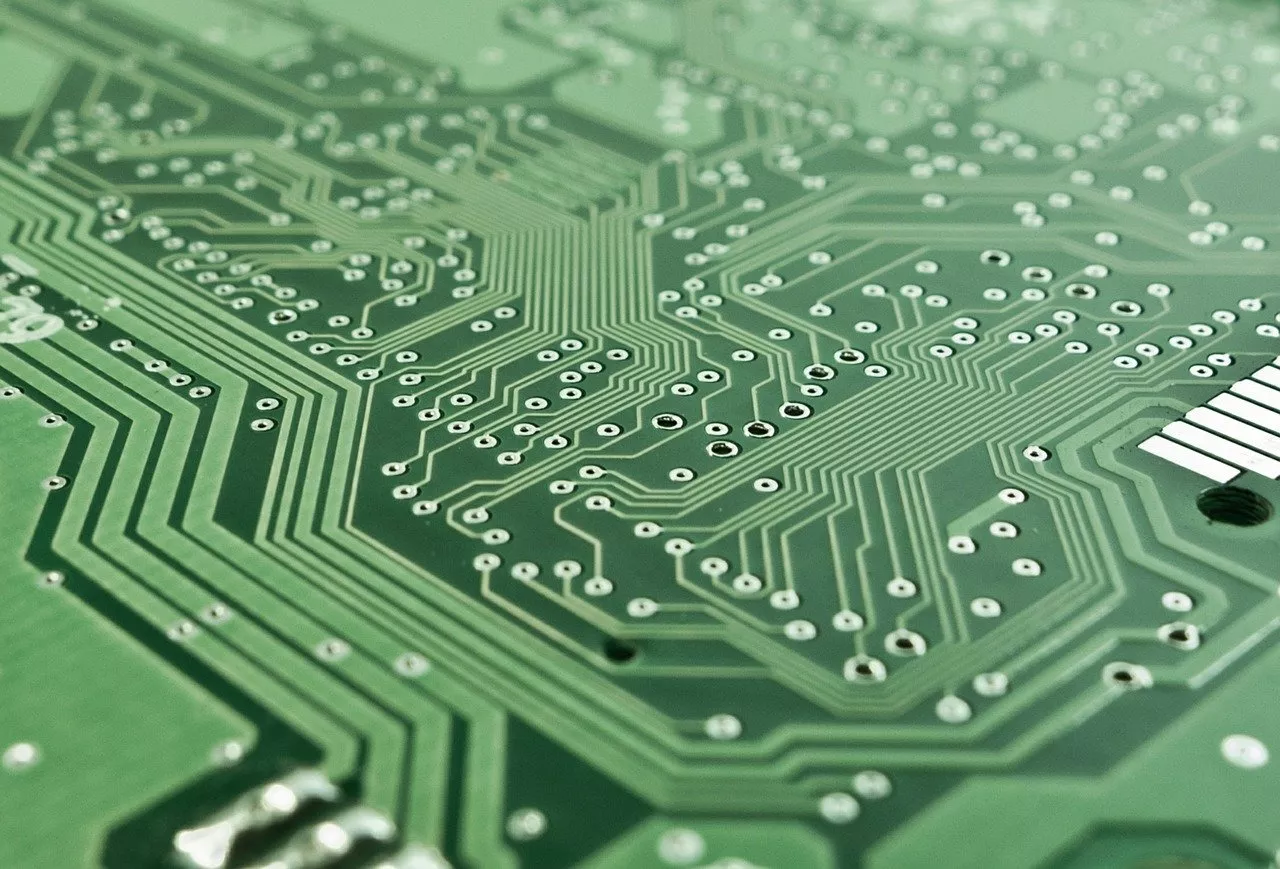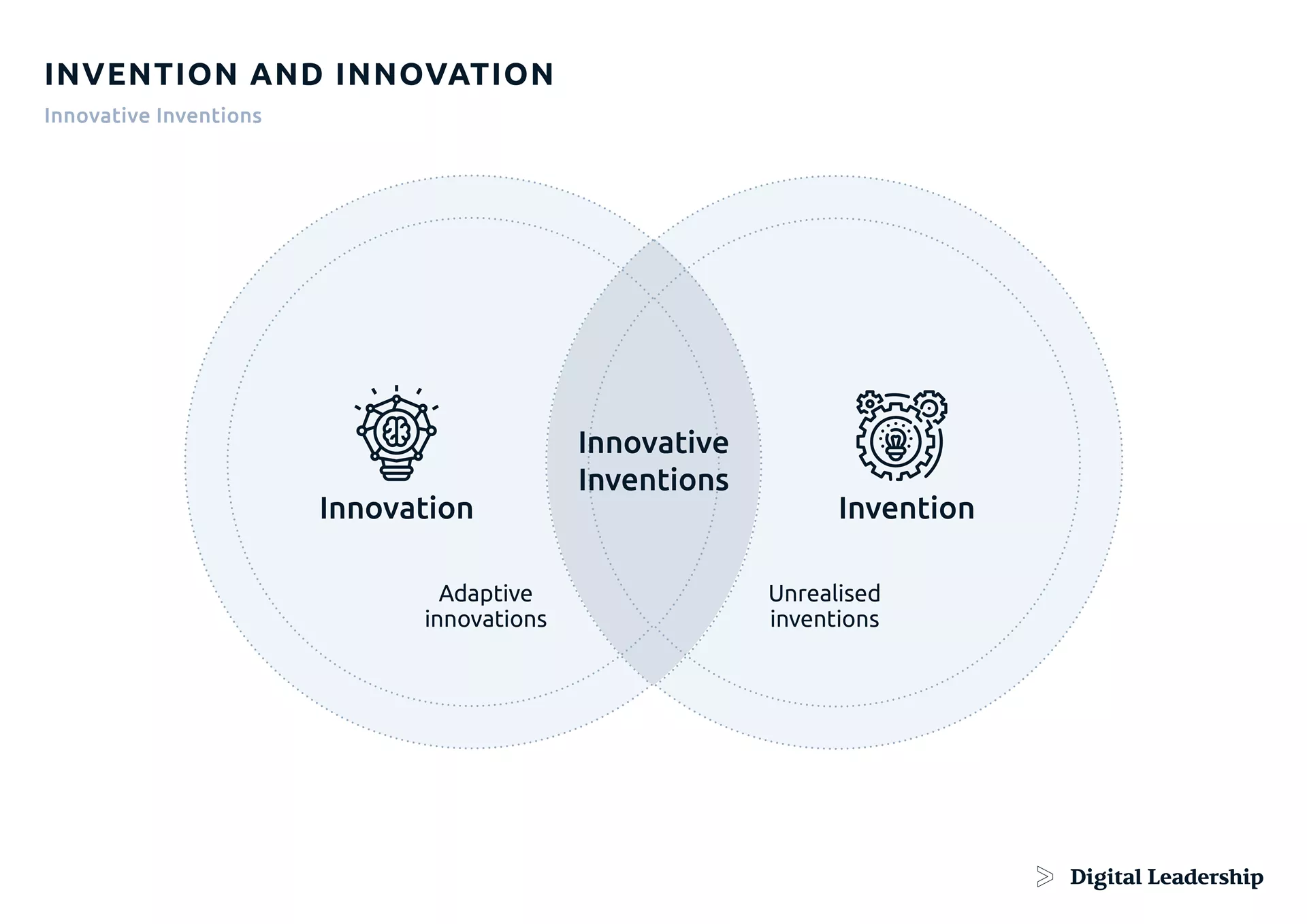Innovation vs Invention: Definition, Difference & Importance
Published: 10 July, 2023
Innovation

Table of Contents
The terms “invention” and “innovation” are frequently used interchangeably, which is not only incorrect but also overlooks important nuances in meaning that can significantly impact a conversation. Invention involves the discovery of something new, while innovation entails the utilization of a novel idea or method.
Innovation is the act of introducing fresh concepts or approaches to the market and transforming existing inventions into practical products or processes that have real-world utility. Some believe that a successful entrepreneurial journey starts with an invention, and the rest is mere “execution”. However, this perspective overlooks the risks and significant differences involved. In this comparison of innovation vs. invention, we aim to highlight and clarify these distinctions.
We at Digital Leadership offer Innovation Consulting to help businesses seize emerging Innovation opportunities. We develop tailored strategies, launch new ventures, and foster positive relationships to drive innovation, transformation, and business growth, benefiting previously neglected consumers.
Innovation Vs Invention:
Innovation and invention are two terms often used interchangeably, but they represent distinct concepts in the realm of creativity and progress. Understanding the fundamental differences between innovation and invention is essential for grasping their unique roles in driving advancements across various fields. Let’s delve into clear definitions of these terms to shed light on their nuanced characteristics.
Definitions
What is an invention?
Invention refers to the initial creation of a product or the introduction of a process, marking its first occurrence. It is the conception of an idea that holds the potential for innovation. Invention addresses a specific problem by utilizing technology, with its technical aspects serving a functional purpose.
The patentability of an invention relies on its technical character, which necessitates the application of natural laws to achieve the desired outcome. Invention is often referred to as a “teaching for technical action.”
Innovation definition
The term “innovation” originates from the Latin verb “innovāre”, which means introducing new things, ideas, or ways of doing something. Unlike improvement or transformation, innovation involves doing something entirely different from what is already being done, rather than just doing it better.
Innovation has permeated various domains of life, leading to diverse applications in business, politics, society, and science. Its expansive nature reflects the potential for innovation in all areas of life.

Since de facto all areas of life form potential areas of innovation, it is not surprising that the concept of innovation has practically taken on a life of its own in recent years and has accordingly found quite different uses in business, politics, society, and science.
This fact can perhaps also serve as an explanation for the fact that to date there is neither a self-contained innovation theory nor a generally accepted definition of innovation or the concept of it.
Furthermore, we want to address the risks if the assumption that innovation is just the execution of an invention is actually adopted. Much more about innovation you will find in our new book “How to Create Innovation” which includes comprehensive approaches with mindsets, structures, and strategies to innovate in less time, with fewer resources, and more success. Register for the download now!
Related: Types of Innovation in Business – How to Choose yours?
Innovation Vs Invention
| Basis for Comparison | Invention | Innovation |
| Meaning | Invention refers to the occurrence of a completely new idea for a product or process that has never been created before. | Innovation involves the implementation of an idea for a product or process that is being introduced for the first time. |
| What is it? | Invention involves the creation of a fresh product. | Innovation focuses on adding value to something that already exists. |
| Concept | Invention is based on an original idea and its theoretical workings. | Innovation is characterized by the practical implementation of a new idea. |
| Skills required | Invention typically requires scientific skills. | Innovation necessitates a combination of marketing, technical, and strategic skills. |
| Occurs when | Invention occurs when a new idea strikes a scientist or inventor. | Innovation arises when there is a perceived need for a new product or an improvement to an existing product. |
| Concerned with | Invention is primarily concerned with a single product or process. | Innovation encompasses the integration of various products and processes. |
| Activities | Invention activities are often limited to the Research and Development (R&D) department. | Innovation activities are spread across the organization, involving multiple departments and stakeholders. |
Why Innovation Is Not Just The Execution Of An Invention?
The underlying risk of this assumption becomes evident when considering the multitude of inventors who never saw their creations come to practical fruition due to overlooked details or the subsequent success of their inventions being achieved by completely different individuals.
Schumpeter drew a central distinction between these two processes: the invention process and the innovation process. In the realm of “business start-ups,” as Schumpeter contended, it is the innovators who assume the primary role, rather than the inventors.
Related: Digital Business Strategy Definition, Concepts, and Strategies
Furthermore, groundbreaking inventions often require significant time to become market-ready, encounter initial setbacks or lack recognition, and may face public resistance. Consequently, successful entrepreneurs typically emerge as innovators rather than inventors.
These entrepreneurs leverage existing resources, building upon what already exists. This perspective aligns with the observations of Israel M. Kirzner, an esteemed American economist, who underscored the concept of “discovering what already exists.” The core characteristic of an entrepreneur lies in recognizing and rediscovering the significance and potential of existing ideas. Paradoxical as it may seem, there is no need for reinvention when something already exists.
A compelling illustration of this phenomenon is exemplified by the fax machine. Although the invention had been in existence for an extended period, its ultimate utilization and market success were driven by different companies than the original inventors and initial market entrants.
Related: The UNITE Business Model Innovation Patterns
Why Innovation Means More Than Inventing New Products
In an environment where markets change rapidly, the unique selling proposition of once-innovative products can quickly diminish. Consequently, maintaining a state of permanent innovation becomes an imperative for companies. While it is impossible to predict with certainty which good ideas will successfully evolve into innovations, it is certainly possible to make informed forecasts.
Today’s hyped products can swiftly become tomorrow’s interchangeable commodities, intensifying the struggle for the survival of innovative offerings, technologies, and services even before they ascend to the pinnacle of innovation.
The relentless transformation of markets coupled with unceasing competition compels companies to pursue constant renewal as a matter of necessity. This obligation extends across all areas of business and is particularly accentuated within the realm of service portfolios. The global digitization landscape further amplifies the pressure to innovate.
Related: Digitization vs. Digitalization: Differences, Definitions, and Examples
At the crossroads: Decline or turnaround
Failure to renew leads to the risk of falling into the cost trap, where interchangeable services result in lower profit margins. To achieve growth, companies may resort to cost-cutting measures, which in turn require increased efficiency in standard products.
If trapped in this downward spiral, there is limited space for innovation. However, embracing innovation can be the key to initiating a turnaround.
Invention Vs Innovation Examples

| Invention | Description | Innovation |
|---|---|---|
| Microprocessor | The invention of the microprocessor, a small electronic device that serves as the brain of a computer, is credited to Intel’s Ted Hoff and Federico Faggin. | The microprocessor serves as a prime example to illustrate the difference between innovation and invention. The innovation lies in the development and evolution of microprocessors, enabling the creation of countless electronic devices, advancements in computing power, and the foundation for the digital age. |
| Light Bulb | Thomas Edison‘s invention of the practical and commercially viable electric light bulb revolutionized indoor lighting. | The innovation came through the widespread adoption and application of light bulbs, leading to the electrification of cities, the creation of lighting industries, and advancements in lighting technology. |
| Zipper | The invention of the zipper by Gideon Sundback was a fastening device used in clothing, bags, and other products. | The innovation lies in the integration of zippers into various products, streamlining fastening processes, and enabling the development of new designs and functionalities. |
| AT&T | AT&T’s Bell Labs contributed to various inventions such as transistor technology and the solar cell. | The innovation stems from the application and commercialization of these inventions by other companies, leading to advancements in electronics, communication systems, and renewable energy technologies. |
| Xerox | Xerox’s Palo Alto Research Center (PARC) was responsible for inventions like the computer mouse and graphical user interface (GUI). | The innovation occurred when these inventions were adopted and further developed by companies like Apple, leading to the widespread use of GUIs and user-friendly computing interfaces. |
| Solar Cell | The invention of the solar cell, which converts sunlight into electricity, is credited to Bell Labs’ researchers. | The innovation lies in the application of solar cells for generating renewable energy, leading to advancements in solar technology, photovoltaic systems, and the growth of the solar industry. |
| Computer Mouse | The invention of the computer mouse by Douglas Engelbart, an input device that revolutionized computer interaction. | The innovation came from the integration of computer mice into personal computers and their widespread adoption, transforming the way users interacted with graphical user interfaces and facilitating more intuitive navigation. |
| Graphical User Interface (GUI) | Xerox’s PARC contributed to the development of GUI, a visual interface that allows users to interact with digital devices using icons, menus, and windows. | The innovation came when GUIs were incorporated into personal computers, making computing more user-friendly, visually appealing, and accessible to a broader audience. |
| Telephone | The invention of the telephone by Alexander Graham Bell, enabled voice communication over long distances. | The innovation came through the establishment and expansion of telephone networks, leading to the global telecommunications industry and advancements in communication technology. |
| Penicillin | Alexander Fleming’s discovery of the antibiotic substance produced by Penicillium mold. | The innovation lies in the mass production and widespread use of penicillin as a life-saving antibiotic, revolutionizing medical treatment and significantly reducing the impact of infectious diseases. |
| Printing Press | Johannes Gutenberg’s invention of the printing press revolutionized the mass production of books and printed materials. | The innovation came through the dissemination of knowledge, the democratization of information, and the development of publishing industries, contributing to education, cultural exchange, and the spread of ideas. |
| Steam Engine | The invention of the steam engine, with key contributions from James Watt, revolutionized transportation, industrial processes, and power generation during the Industrial Revolution. | The innovation occurred through the integration of steam engines into various applications, enabling advancements in manufacturing, transportation, and the mechanization of industries. |
| Computer | The invention of the computer, a programmable electronic device, can be attributed to multiple pioneers in computing history. | The innovation lies in the continuous development and evolution of computers, leading to advancements in computing power, data processing, artificial intelligence, and transformative changes in various fields and industries. |
| Internet | The creation of the Internet, a global network of interconnected computer systems, involved the contributions of numerous individuals and organizations. | The innovation came through the utilization of the internet for communication, information sharing, e-commerce, social networking, and the digital transformation of society, revolutionizing how we connect, work, and access information. |
Related: Innovation Examples: 10 Companies That Transformed Their Industries
Innovative Vs Inventive
Similarly, to innovation vs. invention, we also want to explain the oftentimes confused usage of their adjectives: Inventive vs. innovative. Two words that are also spelled similarly and pronounced similarly. As for innovation and invention, the terms have slightly different meanings:
| Term | Definition |
|---|---|
| Inventive | Refers to someone who demonstrates the ability to design new things and exhibits creativity in thinking and imagination. An inventive individual is skilled at coming up with original concepts and solutions, often starting from scratch and introducing something completely new. |
| Innovative | Describes someone who introduces new things, ideas, or ways of doing something. An innovative person showcases creativity in thinking and imagination, but their focus lies in taking existing concepts or practices to the next level. They excel in advancing and improving upon established ideas or processes, pushing the boundaries of what is currently known or practiced. |
Related: Creativity and Innovation: Differences, Examples & Definitions
Innovation Vs Invention: What Is More Important?
Invention and innovation are two crucial components of progress and advancement. They are interconnected and rely on each other to drive positive change. Inventions serve as the foundation, laying the groundwork for innovation to flourish. They represent the initial creation of new concepts, ideas, or products that showcase originality and novelty. Inventions demonstrate the credibility of scientific knowledge and require specialized skills and expertise.
Inventions Importance
- Inventions involve the creation of entirely new concepts or ideas.
- Inventions serve as evidence of the credibility of scientific knowledge.
- Inventions require specific skills and expertise.
- Inventions are characterized by their originality and novelty.
- Inventions often yield unexpected results.
- Inventions serve as the foundation or building blocks for innovation.
- Inventions should be prioritized as they lay the groundwork for further progress
Innovations Importance
- Innovation focuses on improving existing concepts, services, or products.
- Innovation contributes significantly to the growth and success of companies.
- Innovation introduces new ideas or ways of doing things while incorporating changes to existing concepts or patterns.
- Innovation provides a technical or competitive advantage.
- Innovation demands a diverse range of skills and expertise.
- Innovation has the ability to attract top talent and creative minds.
- Innovation emerges when there is a need for change within an organization.
Whereas invention can be described as a fundament, innovation can be referred to as the introduction of new things, ideas, or ways of doing something.

If we would need to answer the question of innovation vs. invention: what is more important then, it could be concluded that both play an important role in creating continuous value for a company.
Industry Standard Approach to Innovation
Since we know that the topic of innovation vs. invention will continue to be of significant importance in the future, we would like to share the following excerpt from our book “How to Create Innovation” with you: “We know – innovation is an epic challenge. Depending on where you are and how you play it, your levels of success and the outcomes you create will be drastically different, so a particular result cannot be guaranteed. But if you do not make a major leap forward leveraging this consolidated body of knowledge, ask yourself what is going wrong, and do let us equally know what you have been struggling with.
Using this proposed industry-standard approach to innovations, organizations can create innovation in a target-oriented way, leverage their strengths, create blue oceans, and overcome luck.
The practices we introduced are mostly well-established, have proven themselves in the trenches, or are deeply rooted practices by Silicon Valley players. In addition, there are numerous reads to take you further.
Our contribution was to identify winning practices, add what is missing consolidate everything in a holistic setting, and adapt it to the realities of large organizations.
In addition to this industry-standard approach to innovation, we have a variety of other ground-breaking tools and models. These are available via our download link.
The UNITE Business Model Framework
How to Create Innovation includes a number of canvases that focus on value creation and finding the right business model to meet your customer segment and customer needs. The framework is built to inspire drastic changes that help you find a competitive advantage. Our hope is that your company grows through business model innovation, and so we again encourage you to look deeper into our website and the book.
Here is a summary of the key ingredients of the framework:

Designed By: Digital Leadership AG
Business Models
The centerpiece is the Business Model Canvas, which covers the six main areas of a Business Model (the Operating, Value, Service, Experience, Cost, and Revenue Models).
The eXtended Business Model Canvas adds the immediate business context, including Business Drivers, customers, and the team, as well as the Unfair Advantage.
Detailed Models
A Business Model can be broken out into numerous aspects. Depending on what challenges you face, you can zoom in on your area of interest using an appropriate tool or canvas:
- Your Business Intention and objectives as well as your Massive Transformative Purpose summarize your drivers and give direction to what you do.
- The Value Proposition Canvas details the central components of your offering (the product or service).
- To dig into your Customer Segments, work with data-driven Personas.
- The JTBD Customer Job Statement and Job Map frame the JTBD of your customers.
- The Business Model Environment puts your Business Model in a market context composed of emerging trends and disruptive forces.
- The Innovation Culture Canvas helps you understand and consciously shape a culture that supports innovation.
- The Innovation team structure enables you to draft a team structure for your innovation initiative.
- Using learning and growth metrics, you can measure progress at the initial stages of development. These metrics help you focus on what really matters instead of creating a detailed business plan that will not really help you. Later on, you can expand the financial aspect of the Revenue and Cost Models with a full business case.
- The Operating Model Canvas helps you think through the Operating Model.

































 Book How to Create Innovation
Book How to Create Innovation